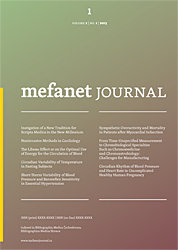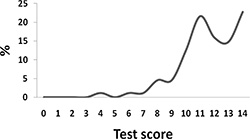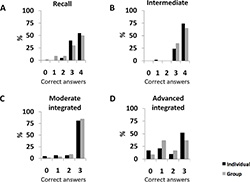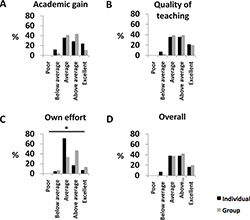
MEFANET Journal 2014; 2(2): 51-55
ORIGINAL ARTICLE
Teaching basic haemorheology to medical students by individual and collaborative strategies
Linea Natalie Toksvang1, Ronan M. G. Berg2*
1 Centre of Inflammation and Metabolism, University Hospital Rigshospitalet, Copenhagen, Denmark
2 Department of Clinical Physiology, Nuclear Medicine & PET, University Hospital Rigshospitalet, Copenhagen, Denmark
* Corresponding author: ronan@dadlnet.dk
Abstract
Article history:
Received 14 July 2014
Revised 17 July 2014
Accepted 8 September 2014
Available online 16 September 2014
Peer review:
Daniel Rajdl, Andrea Pokorná
Download PDF
Supplementary material
We evaluated whether a classic article on haemorheology would lead to better learning when integrated with a collaborative rather than an individual teaching strategy in the undergraduate physiology classroom setting. A total of 88 2nd-year medical students were randomised to solve assignments based on the classic article individually (n=42) or in groups (n=46) during a 45-minute lesson on basic haemorheology. At the end of the lesson, students completed a test and an evaluation form. There were no differences between the two intervention groups with regard to the total test score, but students who had worked in groups rated their own effort during the lesson higher. In the present study, a collaborative teaching strategy did not lead to higher test scores than an individual teaching strategy. However, our findings suggest that students working in groups may feel a greater level of involvement during class.
Keywords
Haemorheology; learning; students, medical; teaching methods
Introduction
In our experience, medical students often find basic haemorheology tremendously difficult, and although it is pertinent to the integrative understanding of microvascular physiology, it is one of the least popular topics within the cardiovascular curriculum. Inspired by the active learning approach “using classic papers to teach physiology” [1], a classic article by Fåhraeus and Lindqvist [2] has recently been reported to be a potentially useful teaching tool when teaching basic haemorheology [3].
In the present study, we evaluated whether this approach would benefit from being integrated with a collaborative teaching strategy in the classroom setting. We hypothesised that students working with the article in groups would attain a better understanding of haemorheology than students working with the article individually.
Methodology
We offered a 45-minute lesson in basic haemorheology to second-year medical students that participated in a 5-week cardiovascular physiology course. A total of 88 students signed up for the lesson, and one week prior to the lesson, they received an e-mail with the article by Fåhraeus and Lindqvist [1] as well as specific references to relevant sections in the three physiology textbooks that are used in our medical school [4–6].
Design
The students were split up in three classes, consisting of 24 (class I), 28 (class II) and 36 students (class III). In class I, all students worked individually, in class II, all students worked in groups, and class III was split into two during the assignments, so that 18 of the students worked individually while the remaining 18 students worked in groups. Thus, a total of 42 students worked individually (intervention group A), while 46 students worked in groups (intervention group B). Each lesson started with an identical 10-minute introduction to the basic principles of haemorheology ex cathedra. During the following 15 minutes, students solved teaching points 1, 4 and 5, as outlined in our former publication on the article by Fåhraeus and Lindqvist [3]. In intervention group A, the students solved each teaching point alone for three minutes, while students in intervention group B worked with each teaching point in groups of 2-3 and then reached a consensus regarding the correct answer within three minutes. After the students had worked with each assignment, the correct answer was highlighted during a 2-minute theoretical recapitulation.
Test
After having worked with the three teaching points, students completed a test of four multiple-choice questions in 10 minutes (Table 1). This test encompassed 1) one recall question comprising four subquestions, 2) one question that was intermediate between a recall and an advanced question and which comprised four subquestions, 3) an integrated question of moderate difficulty comprising three subquestions, and 4) an integrated question of advanced difficulty comprising three subquestions. Each subquestion was either true or false, and one point was designated to each correct answer. A total test score was calculated by adding the scores from all subquestions, with a minimal score of 0 and a maximal score of 14 points. These questions were designed so that the recall question referred directly to information presented in the article by Fåhraeus & Lindqvist [1] as well as during the 10-minute theoretical introduction. The intermediate question also referred to this content, but required the student to use this information in context of a physiological problem. The difficulty of the two integrated questions required the students to apply the haemorheological principles in an integrated physiological manner to solve a problem they had not previously been familiarised with. The integrated questions reached beyond the cardiovascular physiology curriculum in our medical school, and exceed the difficulty of their forthcoming exam.
Evaluation
At the end of the lesson, students completed an evaluation form that was based on a Likert-type scale. They rated 1) the academic gain of the lesson, 2) the quality of the teaching, 3) their own effort during the lesson, and 4) provided an overall assessment of the lesson. Each of these was rated as poor, below average, average, above average or excellent.
Statistics
All data were considered categorical and the Mann-Whitney U-test and chi-squared test were used to compare the two intervention groups. SAS statistical software version 9.2 (SAS Institute Inc., Cary, North Carolina, United States) was used to perform all statistical analyses, and p < 0.05 was considered statistically significant. Data are reported as median (interquartile range) unless otherwise specified.
Table 1. The test
|
1. |
Which of the following applies to the passage of blood through small arteries and arterioles? a. The blood behaves like a Newtonian fluid b. An increase in haematocrit will cause an increase in viscosity* c. There is a progressive increase in viscosity with maximal effect in the precapillary arterioles d. Changes in vessel diameter has a larger effect on perfusion than changes in blood viscosity* |
|
2. |
The axial accumulation of red blood cells in small arteries and arterioles… a. occurs as a consequence of the deformability of red blood cells* b. causes red blood cells to pass through the microvasculature faster than plasma under laminar flow conditions* c. causes an increase in haematocrit as vessel radius decreases d. causes the microvascular resistance to be higher at a given level than would be expected when considering the vessel radius alone |
|
3. |
Red blood cell deformability is reduced in patients with essential hypertension, in whom blood pressure is chronically elevated due to increased arteriolar tone. The reduced deformability of the red blood cells will theoretically lead to… a. reduced*/unchanged/increased axial accumulation of red blood cells during their passage through the microvasculature b. which will reduce/not affect/increase* the total peripheral resistance c. and thus counteract the elevated blood pressure/not affect the blood pressure/increase the elevated blood pressure further* |
|
4. |
Over the years, several attempts to treat severe haemorrhage with haemoglobin solutions as an alternative to blood transfusion have been made. In contrast to blood, these solutions are, however, Newtonian fluids. When a haemoglobin solution, which has the same viscosity as blood in large arteries (diameter above 0.3 mm) is infused… a. the resistance in the large arteries will be increased/unchanged*/reduced compared to normal circumstances b. the resistance in the small arteries and arterioles at a given level will be higher*/unchanged/reduced compared to normal circumstances c. a higher*/similar/lower blood pressure will be required to obtain the same tissue perfusion compared to normal circumstances |
*Correct statement.
Results
Student characteristics and preparation
Students in group B were marginally older than in group A. The two intervention groups did not differ with regard to gender or with proportion that had read the recommended article or the recommended textbook material, nor did they differ with regard to preparation time (Table 2).
Figure 1. Total test scores. The abscissa shows the total test score, calculated as the number of correctly answered subquestions, and the ordinate shows the percentages of all students (n = 88).
Figure 2. Specific test scores. The abscissa shows the number of correctly answered subquestions, and the ordinate shows the percentage of students within the respective intervention group.
Figure 3. Student evaluations. The abscissa shows the evaluation score (Likert-type scale) and the ordinate shows the percentage of students within the respective intervention group. *Overall difference between intervention groups (p < 0.05).
Table 2. Student characteristics
|
|
Individual work (Group A) |
Group work (Group B) |
p-value |
|
Number of students |
42 |
46 |
- |
|
Mean age (SD), years |
22 (1) |
23 (2) |
0.02 |
|
Gender, male/female |
11/31 |
11/35 |
0.50 |
|
Has read the article |
27 (64%) |
31 (67%) |
0.47 |
|
Has read recommended textbook material |
34 (81%) |
35 (76%) |
0.36 |
|
Total preparation time |
|||
|
None |
5 (12%) |
6 (13%) |
0.43 |
|
< 30 min |
7 (17%) |
5 (10%) |
|
|
30–60 min |
21 (50%) |
19 (42%) |
|
|
60–120 min |
7 (17%) |
14 (31%) |
|
|
> 120 min |
2 (4%) |
1 (2%) |
|
|
No answer |
0 |
1 (2%) |
|
Assessment of the textbook material and article
A total of 68 students (77%) had read the recommended textbook material prior to the lesson. Of these, 2 (3%) found the material easy to understand, 38 (56%) found it moderate, and 28 (41%) found it difficult. There was no difference between the two intervention groups with regard to the perceived difficulty of the recommended textbook material (p=0.69). Of the 58 students (66% of all students) who had read the article prior to the lesson, 1 (2%) found the article easy to understand, 39 (67%) found it moderate, and 16 (28%) found it difficult, while 2 (3%) did not reply, with no difference between the two intervention groups (p=0.42). Of the 58 students who had read the article, 1 (2%) found the academic gain from the article to be poor, 13 (22%) found it to be below average, 35 (60%) found it to be average, 7 (12%) above average and 2 (4%) found it to be excellent, with no difference between the two intervention groups (p=0.51).
Test scores
The total test score in all 88 students was 12 (11–13) correct answers, with 20 (23%) reaching a test score of 100% (14/14 correct answers) (Figure 1). There were no differences between the two intervention groups with regard to the total test score, nor with regard to their specific scores on recall, intermediate, moderate integrated, or advanced integrated questions (Figure 2A–D). Moreover, total test score did not differ between students that had read the article prior to the lesson and those who had not, neither when looking at all 88 students as a whole (p=0.19) nor when looking at the two intervention groups separately (group A: p=0.42; group B: p=0.21). Similarly, no differences were present when looking at specific scores on recall, intermediate, moderate integrated, and advanced integrated questions separately (Supplementary Tables A and B).
Evaluation
Students in the two intervention groups evaluated the academic gain and the quality of the teaching similarly (Figure 3A–B), whereas group B students rated their own effort higher than group A students; hence 30 (71%) of the students in group A rated their effort as average, whereas 10 (24%) rated as above average or excellent, while 15 (33%) of the students in group B rated their effort as average and 27 (59%) rated it as above average or excellent (Figure 3C). Nevertheless, the two intervention groups did not differ in their overall assessment of the lesson (Figure 3D).
Discussion
The main finding of the present study is that in contrast to our working hypothesis, working with the article in groups was not associated with higher test scores than working with the article individually, but the students did rate their own effort as higher when working in groups.
In contrast to a number of previous studies, which have repeatedly demonstrated that collaborative teaching strategies improve both the transfer and retention of the learned material in the classroom setting [7–10], we did not find that students who had worked in groups reached higher test scores than students who had worked individually. A remarkably large proportion of students in both intervention groups replied appropriately to integrated questions of both moderate and advanced difficulty, which may imply that working with the three teaching points enabled the students to transfer the learned material, regardless of the intervention. Based on the data at hand, we cannot rule out that an actual difference between the two intervention groups is in fact present, both due to the relatively low number of participants and because a difference is difficult to demonstrate when considering the high test scores in both intervention groups.
Although evaluations for the most part did not differ between the intervention groups, students working in groups did perceive their own effort during the lesson as higher. Notwithstanding that it cannot uncritically be inferred from our findings whether this perceived higher effort is considered positive or negative among the students, it may imply a higher level of student involvement in class. Accordingly, previous studies likewise found that collaborative teaching strategies lead to better evaluations both in the classroom [7–10] and laboratory [11] setting, presumably because it makes students more active in the educational process.
In conclusion, the present study indicates that both individual and collaborative teaching strategies may lead to acceptable test scores in basic haemorheology. Furthermore, working in groups may possibly lead to higher student satisfaction, since students then feel a greater level of involvement in class.
References
1. Fåhraeus R, Lindqvist T. The viscosity of the blood in narrow capillary tubes. Am J Physiol 1931; 96(3): 562-568.
2. Toksvang LN, Berg RMG. Using a classic paper by Robin Fåhraeus and Torsten Lindqvist to teach basic hemorheology. Adv Physiol Educ 2013; 37(2): 129-133.
3. Raff H. Using classic papers to teach physiology. Adv Physiol Educ 2005; 29(3): 138.
4. Boron WF, Boulpaep EF. Medical Physiology. 2nd edition. Saunders Elsevier, Philadelphia 2012.
5. Hall JE. Guyton and Hall Textbook of Medical Physiology. 12th edition. Saunders Elsevier, Philadelphia 2010.
6. Koeppen BM, Stanton BA. Berne & Levy Physiology. 6th edition. Mosby Elsevier, Philadelphia 2010.
7. Cortright RN, Collins HL, Rodenbaugh DW, DiCarlo SE. Student retention of course content is improved by collaborative-group testing. Adv Physiol Educ 2003; 27(1-4): 102-108.
8. Giuliodori MJ, Lujan HL, DiCarlo SE. Collaborative group testing benefits high- and low-performing students. Adv Physiol Educ 2008; 32(4): 274-278.
9. Rao SP, Collins HL, DiCarlo SE. Collaborative testing enhances student learning. Adv Physiol Educ 2002; 26(1-4): 37-41.
10. Rao SP, DiCarlo SE. Active learning of respiratory physiology improves performance on respiratory physiology examinations. Adv Physiol Educ 2001; 25(1-4): 127-133.
11. Berg RMG, Plovsing RR, Damgaard M. Teaching baroreflex physiology to medical students: a comparison of quiz-based and conventional teaching strategies in a laboratory exercise. Adv Physiol Educ 2012; 36(2): 147-153.
Supplementary material
Supplementary Table A. Test scores in students working individually (n=42), according to whether they had read the recommended article prior to the lesson.
|
|
Has read article (n=27) |
Has not read article (n=15) |
p-value |
|
Total test score (correct answers, 0–14) |
13 (11–14) |
12 (11–13) |
0.42 |
|
No. of correctly answered recall questions |
15 (56%) |
8 (67%) |
0.86 |
|
No. of correctly answered intermediate questions |
20 (74%) |
11 (73%) |
1.00 |
|
No. of correctly answered moderate integrated questions |
22 (81%) |
12 (80%) |
0.98 |
|
No. of correctly answered advanced integrated questions |
15 (56%) |
7 (58%) |
0.42 |
Supplementary Table B. Test scores in students working in groups (n=46), according to whether they had read the recommended article prior to the lesson.
|
|
Has read article (n=31) |
Has not read article (n=15) |
p-value |
|
Total test score (correct answers, 0–14) |
12 (11–13) |
11 (9–13) |
0.21 |
|
No. of correctly answered recall questions |
16 (52%) |
7 (58%) |
0.31 |
|
No. of correctly answered intermediate questions |
22 (71%) |
8 (67%) |
0.34 |
|
No. of correctly answered moderate integrated questions |
26 (84%) |
13 (87%) |
0.96 |
|
No. of correctly answered advanced integrated questions |
12 (39%) |
5 (33%) |
0.91 |
Please cite as:
Toksvang LN, Berg RMG. Teaching basic haemorheology to medical students by individual and collaborative strategies. MEFANET Journal 2014; 2(2): 51-55. Available at WWW: http://mj.mefanet.cz/mj-04140714.
This is an open-access article distributed under the terms of the Creative Commons Attribution-NonCommercial-ShareAlike 3.0 License (http://creativecommons.org/licenses/by-nc-sa/3.0/), which permits unrestricted use, distribution, and reproduction in any medium, provided the original work, first published in the MEFANET Journal, is properly cited. The complete bibliographic information, a link to the original publication on http://www.mj.mefanet.cz/, as well as this copyright and license information must be included.













